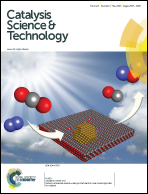Post-synthesis incorporation of Al into germanosilicate ITH zeolites: the influence of treatment conditions on the acidic properties and catalytic behavior in tetrahydropyranylation
Abstract
Post-synthesis alumination of germanosilicate medium-pore ITH zeolites was shown to be an effective procedure for tuning their acidity. Treatment of ITH zeolites synthesized with different chemical compositions (i.e. Si/Ge = 2.5, 4.4 and 5.8) with aqueous Al(NO3)3 solution led to the formation of strong Brønsted and Lewis acid sites and an increasing fraction of ultramicro- and meso-pores in Ge-rich ITH samples (Si/Ge = 2.5 and 4.4). The concentration of Al incorporated into the framework increases with decreasing Si/Ge ratio of the parent ITH. The increasing temperature of alumination from 80 to 175 °C (HT conditions) resulted in (1) a 1.5–2-fold increase in the concentration of Brønsted acid sites formed and (2) a decreasing fraction of framework Al atoms detectable with base probe molecules (i.e. pyridine, 2,6-di-tert-butylpyridine), i.e. an increased concentration of the “inner” acid sites. The activity of prepared Al-substituted ITH zeolites in tetrahydropyranylation of alcohols is enhanced with increasing amount of accessible acid sites in bulky crystals (e.g. alumination at lower temperature) or with increasing total concentration of acid centres within tiny ITH crystals (e.g. alumination under HT conditions). This trend became more prominent with increasing kinetic diameter of the substrate molecules under investigation (methanol < 1-propanol < 1-hexanol).


 Please wait while we load your content...
Please wait while we load your content...